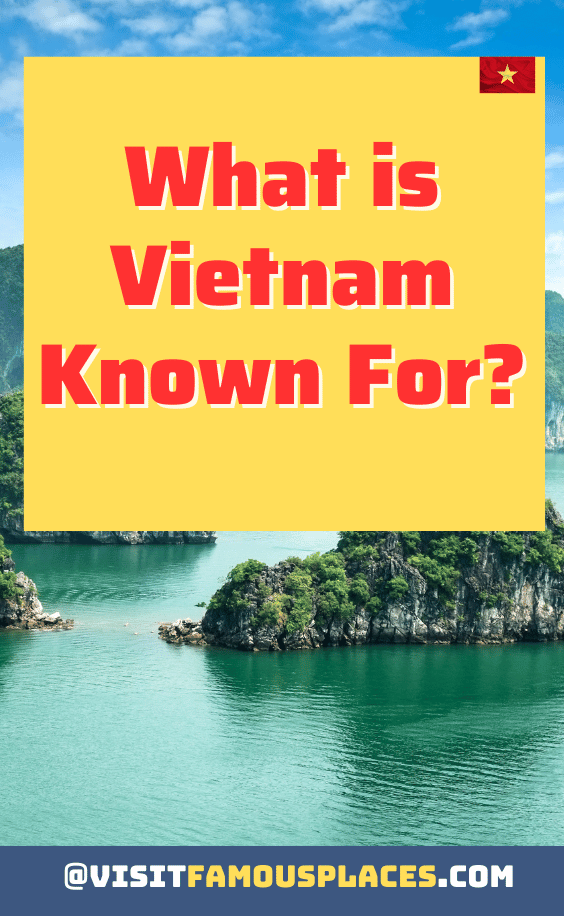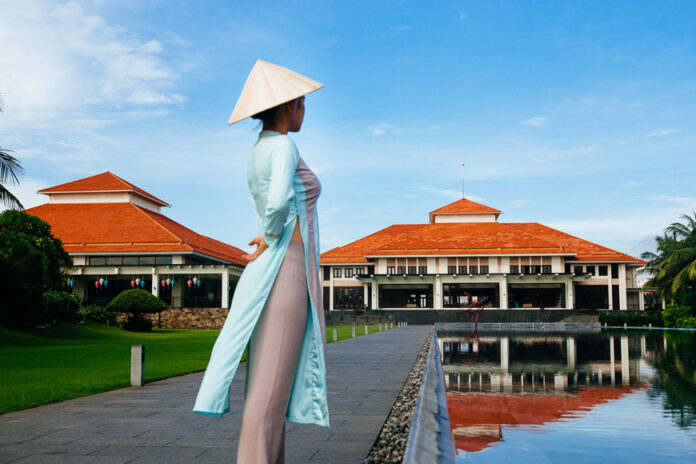Vietnam, a captivating Southeast Asian country, is renowned for its rich history, vibrant culture, picturesque landscapes, delectable cuisine, and much more. From its tumultuous past to its flourishing tourism industry and economic growth, Vietnam has emerged as an intriguing destination for travelers from around the world. This article aims to delve into the various facets that make Vietnam truly special.
What is Vietnam Known For?

1. Vietnam’s History and Culture

- Ancient origins: Explore Vietnam’s ancient roots dating back to the Dong Son culture and the legendary Hung Kings. Gain insights into the country’s early civilizations and their contributions.
- Chinese influence: Understand how China’s rule during the period of domination impacted Vietnam’s language, literature, philosophy, and governance systems.
- French colonization: Examine the enduring French influence on Vietnamese architecture, education, cuisine, and the introduction of Catholicism.
- Independence struggle: Learn about Vietnam’s arduous journey toward independence, spearheaded by iconic figures like Ho Chi Minh and the Viet Minh.
- Modern Vietnam: Discover how Vietnam has evolved since gaining independence, including the establishment of the Socialist Republic of Vietnam and its dynamic political landscape today.
2. Natural Landscapes of Vietnam

- Ha Long Bay: Be enthralled by the breathtaking limestone karsts jutting out of emerald waters, creating a surreal seascape recognized as a UNESCO World Heritage Site.
- Sapa Valley: Immerse yourself in the mist-shrouded mountains of northern Vietnam, replete with terraced rice fields, ethnic minority villages, and an enchanting cultural tapestry.
- Phong Nha-Ke Bang National Park: Venture into this remarkable park featuring magnificent caves, underground rivers, and awe-inspiring biodiversity, including the world’s largest cave, Son Doong.
- Mekong Delta: Cruise along the iconic Mekong River, witness floating markets, and explore the lush, fertile landscapes that sustain Vietnam’s agricultural heartland.
- Da Lat: Experience the charm of the Central Highlands, with its temperate climate, scenic waterfalls, verdant pine forests, and tranquil lakes.
3. Vietnamese Cuisine and Street Food

- Pho: Delight in Vietnam’s most iconic dish, a flavorsome noodle soup typically featuring beef or chicken, aromatic herbs, and rice noodles.
- Banh Mi: Indulge in this delectable fusion of French and Vietnamese cuisine—a crusty baguette filled with various savory ingredients like grilled meats, pâté, pickled vegetables, and fresh herbs.
- Com Tam: Discover the tantalizing flavors of broken rice served with grilled pork chops, steamed egg, pickled vegetables, and a drizzle of fish sauce.
- Bun Cha: Experience the harmony of grilled pork patties, vermicelli noodles, fresh herbs, and a sweet and tangy dipping sauce—a Hanoi specialty.
- Banh Xeo: savor the crispy pancake made from rice flour, turmeric powder, coconut milk, and stuffed with succulent fillings such as shrimp, pork, bean sprouts, and herbs.
4. Vietnam’s UNESCO World Heritage Sites

- Hoi An Ancient Town: Explore this well-preserved trading port from the 15th to the 19th century, showcasing a fusion of Vietnamese, Chinese, and Japanese architectural styles.
- Hue Imperial City: Step back in time and wander through the majestic palaces, temples, and imperial tombs that once belonged to the Nguyen Dynasty.
- My Son Sanctuary: Marvel at the ancient Hindu temples nestled amidst lush greenery, serving as a testament to the Champa Kingdom’s cultural and architectural prowess.
- Phong Nha-Ke Bang National Park: Delve into the park’s geological wonders, including its remarkable caves, underground rivers, and stunning karst formations.
- Citadel of the Ho Dynasty: Visit the remnants of this UNESCO-listed citadel, an impressive example of medieval military architecture.
5. Vietnam War and Its Impact

- Historical context: Gain an understanding of the VietnamWar’s historical context, including its origins in the Cold War and the division between North and South Vietnam.
- Key events: Explore significant events during the war, such as the Gulf of Tonkin incident, the Tet Offensive, and the fall of Saigon.
- Impact on Vietnam: Examine the devastating consequences of the war, including civilian casualties, displacement, and the lasting effects of Agent Orange.
- Vietnam’s reunification: Learn about the country’s reunification under communist rule and the subsequent challenges faced during the post-war period.
- War tourism: Discover how Vietnam has transformed some of its wartime sites into tourist attractions, offering visitors a chance to learn about the war’s history.
6. Famous Tourist Destinations in Vietnam

- Ho Chi Minh City: Experience the bustling metropolis formerly known as Saigon, with its vibrant street life, historic landmarks like the Reunification Palace, and lively markets.
- Hanoi: Immerse yourself in the capital city’s rich history, exploring attractions such as the Ho Chi Minh Mausoleum, the Temple of Literature, and the enchanting Old Quarter.
- Hoi An: Wander through the ancient town’s narrow streets lined with colorful buildings, visit its ornate temples, and admire the iconic Japanese Covered Bridge.
- Nha Trang: Enjoy the pristine beaches and turquoise waters of this coastal city, indulge in water sports, and explore nearby islands.
- Da Nang: Discover the Marble Mountains, stroll along the famous My Khe Beach, and witness the remarkable Dragon Bridge illuminated at night.
7. Traditional Vietnamese Clothing and Ao Dai

- Ao Dai: Learn about Vietnam’s traditional attire, the elegant Ao Dai, characterized by its long, form-fitting tunic worn over pants. Explore its historical significance and variations.
- Non La: Discover the iconic conical hat, known as Non La, which plays both a practical and cultural role in Vietnam, providing shade and representing Vietnamese identity.
- Ethnic minority costumes: Explore the diverse range of traditional clothing worn by Vietnam’s ethnic minority groups, each reflecting unique customs, symbols, and craftsmanship.
8. Vietnamese Festivals and Celebrations

- Tet Nguyen Dan (Lunar New Year): Experience Vietnam’s most important and vibrant festival, marked by family gatherings, ancestral worship, dragon dances, and colorful decorations.
- Mid-Autumn Festival: Discover the enchantment of this festival, celebrated with lantern processions, mooncakes, and lively performances, particularly enjoyed by children.
- Hue Festival: Immerse yourself in the biennial celebration of arts and culture, featuring traditional music, dance performances, and a vibrant parade.
- Perfume Pagoda Festival: Witness the annual pilgrimage to the Perfume Pagoda, where devotees seek blessings and pay homage to Buddhist traditions amidst breathtaking natural surroundings.
9. Economic Growth and Development in Vietnam

- Doi Moi reforms: Explore the economic reforms implemented in the late 1980s, transitioning Vietnam from a centrally planned economy to a socialist-oriented market economy.
- Foreign investment: Understand the role of foreign investment in Vietnam’s economic growth, particularly in sectors such as manufacturing, textiles, and technology.
- Export industry: Learn about Vietnam’s thriving export industry, including garments, electronics, agricultural products, and an increasing focus on high-value manufacturing.
- Rise of tourism: Examine the significant contributions of tourism to Vietnam’s economy, with a growing number of international visitors drawn to the country’s attractions.
- Infrastructure development: Discover the ongoing efforts to enhance infrastructure, including the construction of highways, airports, and urban development projects.
10. Vietnamese Art, Music, and Film

- Traditional art forms: Explore traditional Vietnamese art forms such as lacquerware, silk painting, water puppetry, and woodblock prints, each reflecting Vietnam’s cultural heritage.
- Contemporary art scene: Learn about Vietnam’s vibrant contemporary art scene, with emerging artists pushing boundaries and expressing diverse perspectives.
- Traditional music: Discover the melodic sounds of traditional Vietnamese music, including genres like Hat Xam, Quan Ho, and Ca Tru, oftenperformed with traditional instruments such as the dan bau and the monochord.
- Pop music: Explore Vietnam’s modern pop music industry, with popular artists and catchy tunes enjoyed by the younger generation.
- Vietnamese film industry: Learn about the growth of the Vietnamese film industry, notable filmmakers, and acclaimed movies that have garnered international recognition.
Conclusion
Vietnam is a country that encompasses a rich tapestry of history, culture, natural wonders, cuisine, and artistic expression. From its tumultuous past, symbolized by the Vietnam War, to its rapid economic growth and thriving tourism industry, Vietnam has emerged as a captivating destination for travelers seeking diverse experiences. Whether exploring the ancient streets of Hoi An, savoring the flavors of Vietnamese street food, or immersing oneself in the fascinating history and traditions, Vietnam offers a multitude of reasons to visit and explore. With its stunning landscapes, UNESCO World Heritage Sites, vibrant festivals, and warm hospitality, Vietnam continues to captivate the hearts of those who venture there.





















